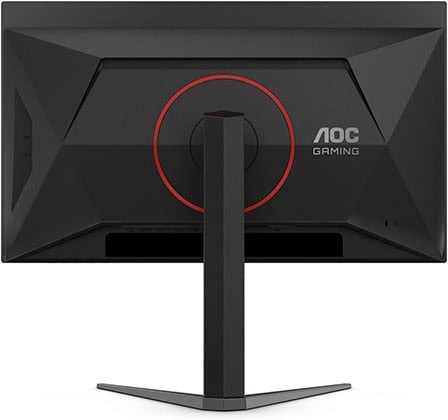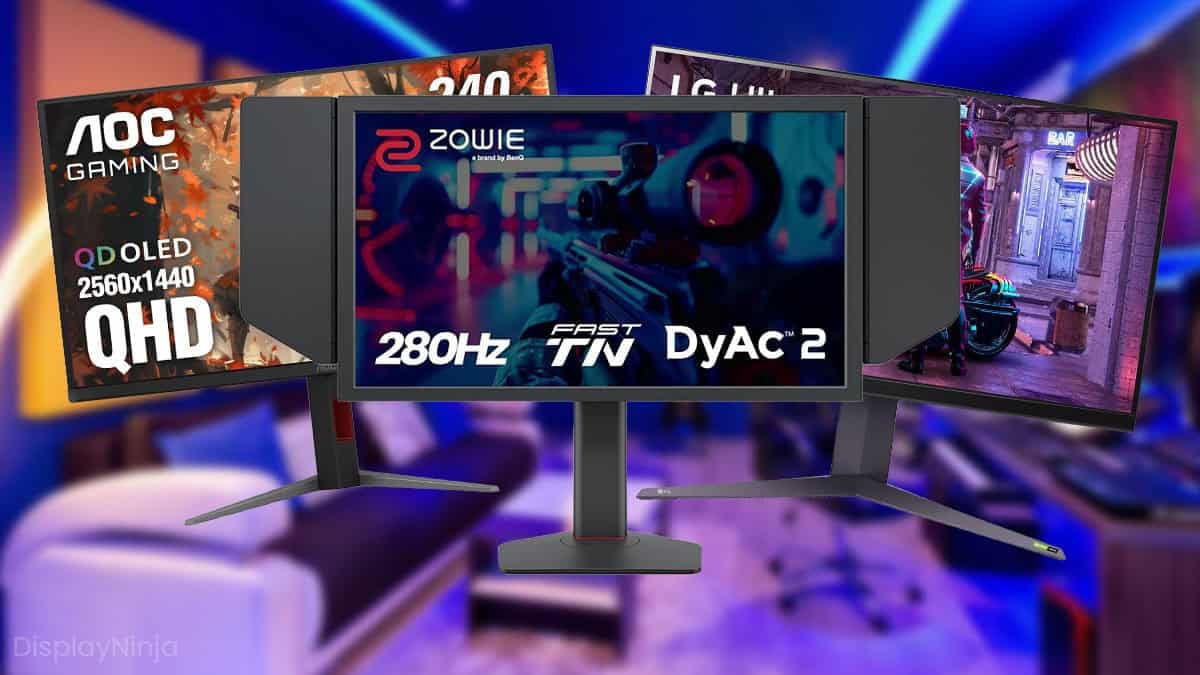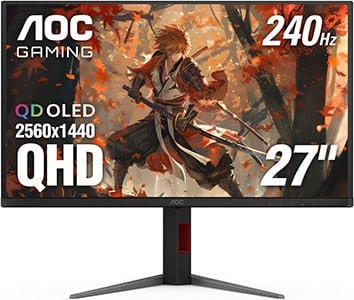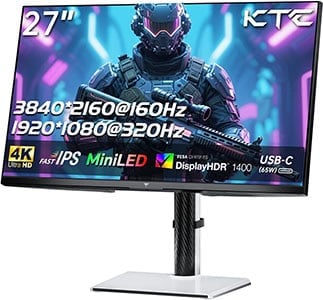For under $500, you can get one of the best displays for competitive eSports gaming, an OLED display or a great 32″ 1440p 240Hz display for mixed use.
Deciding which one is the best for you depends on what type of games you mostly play as well as on your PC configuration.
In this guide, we’ll help you decide which is the best gaming monitor under 500 USD for you!
| Type | Monitor | Size | Resolution | Panel | Refresh Rate | VRR | |
|---|---|---|---|---|---|---|---|
| Best 1080p Monitor | 24.1” | 1920x1080 | TN | 280Hz | FreeSync (G-SYNC Stable) | ||
| Best 1440p Gaming Monitor | 32” | 2560x1440 | IPS | 260Hz | FreeSync (G-SYNC Stable) | ||
| Best OLED Monitor | 27” | 2560x1440 | OLED | 240Hz | FreeSync (G-SYNC Stable) | ||
| Best Mini LED Monitor | 27” | 3840x2160 | IPS | 160Hz, 1080p 320Hz | FreeSync (G-SYNC Stable) |
Now, in order to ensure you’re getting the perfect monitor for your needs and preference, stick to our guidelines and tips in the monitor reviews below.
Additionally, you can visit our comprehensive gaming monitor buyer’s guide, where you can learn more about what’s the best panel type, refresh rate, screen size and resolution for you, as well as what other features you should look out for.
This guide only includes three models – there are a lot more monitors you can find for under $400. For more expensive options, check out our dedicated best gaming buyer’s guide.
If you want to view our changelogs for this particular buying guide, you can do so at the end of this article.
Best 1080p Gaming Monitor Under $500
BenQ ZOWIE XL2546X+
Best 1080p 280Hz Gaming Monitor Under $500
Size: 24.1″
Resolution: 1920×1080
Panel: TN
Refresh Rate: 280Hz
VRR: FreeSync (G-SYNC Stable)
The Pros:
- Plenty of gaming features, including VRR and MBR up to 280Hz
- Low input lag
- Exceptional response time and MBR performance
- Fully ergonomic design
The Cons:
- Narrow viewing angles
- Expensive
About the Monitor
The BenQ ZOWIE XL2546X+ has a 280Hz refresh rate, a rapid pixel response time speed, impeccable backlight strobing implementation and plenty of additional useful features for competitive gaming.
Image Quality
To start with, the XL2546X+ uses a TN panel. Now, this means that it has narrower viewing angles than that of IPS, which causes the image to shift in gamma and saturation at skewed angles, but as long as you’re sitting directly in front of the display, it won’t be an issue.
The main advantage is that this TN panel has a faster pixel response time speed for zero ghosting behind fast-moving objects.
In addition, its DyAc 2 implementation works all the way up to 280Hz and it’s perfectly tuned to have no strobe crosstalk or brightness penalty, allowing you to maintain stunning CRT-like motion clarity at full 320-nits.
BenQ also boasts plenty of Zowie-exclusive features, such as XL Setting To Share (apply game-specified settings created by professional players), Black eQualizer and Color Vibrance.
Design & Connectivity

The stand is designed with professional gaming in mind as it doesn’t take up a lot of desk space yet it’s sturdy and allows you to place your keyboard close to the screen.
You also get extensive ergonomic support with up to 155mm height adjustment (with precise positioning), -5°/35° tilt, +/- 45° swivel and 100x100mm VESA mount compatibility.
Along with the monitor, you also get the S. Switch device for quick and remote OSD-related tweaks and shading flaps to minimize distractions.
Connectivity options include three HDMI 2.0 ports, DisplayPort 1.2 and a headphone jack.
Best 1440p Gaming Monitor Under $500
The combination of 1440p resolution and 144Hz+ refresh rate is the favorite among most gamers. Here, you’ll find the best 32″ model available under $500.
LG 32GQ850
Best 32″ 1440p 240Hz IPS Gaming Monitor
Size: 32″
Resolution: 2560×1440
Panel: IPS
Refresh Rate: 240Hz (260Hz OC)
VRR: FreeSync (G-SYNC Stable)
The Pros:
- Exceptional 98% DCI-P3 gamut
- Quick response time speed
- Plenty of gaming features, including VRR up to 260Hz
- Ergonomic stand, USB hub
The Cons:
- IPS glow and mediocre contrast ratio (as expected from this panel technology)
About the Monitor
If you want a 1440p high refresh rate IPS gaming monitor with a 32″ sized screen, check out the LG 32GQ850!
Image Quality
1440p resolution won’t look quite as crisp on the 31.5″ viewable screen of the LG 32GQ850 (93 PPI) as it does on 27″ monitors (108 PPI).
In fact, you get the same detail clarity as you would with a 24″ 1080p monitor, just a much bigger screen and more screen space due to the higher 1440p resolution.
A lot of people, especially FPS gamers, also find 32″ monitors to be too big as they have to move their head/eyes more, putting them at a competitive disadvantage.
However, the image still looks quite crisp and since you’ll be sitting a bit further away from a 32″ screen (in comparison to 24″), individual pixels won’t be noticeable and you’ll get a more immersive gaming experience.
The monitor has an exceptional 98% DCI-P3 gamut (~135% sRGB) with a provided sRGB emulation mode; the contrast ratio is 1,000:1 as expected from IPS technology, while the peak brightness is very good at 400-nits for SDR content and 600-nits for HDR.
Finally, it boasts a fast 1ms GtG pixel response time speed that eliminates visible trailing behind fast-moving objects.
The LG 32GQ850 supports VRR up to 260Hz for tear-free gameplay. Other features include custom crosshair overlays, Black Stabilizer and hardware calibration.
Design & Connectivity

The stand is robust and offers a good range of ergonomics including up to 110mm height adjustment, -5°/15° tilt, 90° pivot and 100x100mm VESA mount compatibility.
Connectivity options include DisplayPort 1.4, two HDMI 2.1 inputs, a headphone jack (with DTS HP:X) and a dual-USB 3.0 hub.
Best HDR Gaming Monitor
Want proper HDR support? The following display offers incredible HDR viewing experience thanks to its OLED panel.
AOC Q27G4ZD
Best OLED Monitor Under $500
Size: 27″
Resolution: 2560×1440
Panel: OLED
Refresh Rate: 240Hz
VRR: FreeSync (G-SYNC Stable)
The Pros:
- Infinite contrast ratio
- Wide color gamut
- Decent peak brightness
- Instant response times
- Plenty of features, including VRR up to 240Hz
- Ergonomic stand
The Cons:
- Risk of burn-in (covered by 3-year warranty)
- Not as bright as mini LED displays
About the Monitor
Nowadays, you can even find an OLED gaming display for under $500 on sale, the AOC Q27G4ZD!
Image Quality
Unlike LED-backlit panels, OLED displays produce their own light with each individual pixel. This means that they can simply turn off and deliver true blacks with an infinite contrast ratio and no FALD blooming, glowing, bleeding or other visual artifacts!
Further, they have instantaneous pixel response time speed, which is perfect for fast-paced games as there’s zero ghosting behind fast-moving objects.
The AOC Q27G4ZD also has a high 240Hz refresh rate, smooth VRR performance and plenty of useful features, such as crosshair overlays, Shadow Control, on-screen timers, etc.
The main downside of OLED displays is the risk of burn-in. If an image with bright static elements remains on the screen for too long, those bright elements may burn in and become permanently visible as an afterimage.
However, AOC offers plenty of burn-in prevention features (Pixel Refresh, Auto Warning, Pixel Orbiting), so as long as you’re using the monitor sensibly, it shouldn’t be an issue. There’s even a 3-year warranty that covers burn-in.
Another downside is that the brightness is not as high as that of mini LED displays with 250-nits peak for 100% APL (Average Picture Level, white window test size) and in HDR, up to 450-nits for 10% and 1000-nits for < 3% APL.
Regardless, this is enough for an eye-catching HDR viewing experience with punchy highlights, true blacks and vibrant colors thanks to the 99.3% DCI-P3 color gamut coverage and true 10-bit color depth. Viewing angles are also impeccable.
Design & Connectivity

The AOC Q27G4ZD has a sturdy stand with up to 130mm height adjustment, +/- 90° pivot, +/- 30° swivel, -5°/23° tilt and 100x100mm VESA mount compatibility.
Like most QD-OLED monitors, it has a semi-glossy coating that makes the image more vivid, but it’s also more reflective and causes raised blacks under direct lighting, so you have to mind the lighting in your room.
Connectivity options include DP 1.4, two HDMI 2.0 ports, a quad-USB 3.0 hub and a headphone jack.
Alternatives
If you’d rather have a mini LED HDR monitor, check out the KTC M27P6.
Conclusion
Still not sure what monitor to get?
Leave us a comment below, and we’ll gladly help you out.
If you’re mainly playing competitive FPS games, the BenQ XL2546X+ will provide you with the smoothest motion and lowest input latency.
For HDR gaming, the AOC Q27G4ZD is definitely the best option available for under $500, while the LG 32GQ850 is a decent option if you prefer 32″ sized screens and aren’t interested in HDR.
Updates +
- July 9, 2025:
– Added the KTC M27P6 to the table. A review summary will be added soon. - June 1, 2025:
– Replaced the MSI MAG 271QPX E2 with the AOC Q27G4ZD.
– Replaced the BenQ XL2546X with XL2546X+.
– Replaced the Gigabyte FI32Q-X with the LG 32GQ850.
– Removed the Acer XV252QF, the Acer XR343CKP, the Arzopa M3RC, the Innocn 27M2V and the Innocn 34M1R. These are either discontinued or now available for less than $500 (or cost over $500). - December 31, 2024:
– Replaced the LG 32GR93U with the MSI MAG 322UPF.
– Added the MSI MAG 271QPX E2 as we’ve seen it often go on sale for $499.
– Removed the AOC AG274QZM, the MSI MAG 321CUP and the MSI MAG 323UPF.
– Added review summary for the Innocn 34M1R. - November 22, 2024:
– Added the MSI MAG323UPF, the MSI MAG321CUP, the AOC AG274QZM, the Innocn 34M1R and the AOC AG276QZD2 to the table. Review summaries will be added soon. - August 8, 2024:
– Added the BenQ XL2546X, the Gigabyte FI32Q-X, the LG 32GR93U and the Innocn 27M2V.
– Removed the KTC M27T20, the ASUS PG329Q, the HP Omen 27qs, The Cooler Master GM34, the MSI MAG401QR, the Gigabyte M27U and the MSI G321CU. - December 12, 2023:
– Replaced the Gigabyte M34WQ with the Acer XR343CKP. - November 14, 2023:
– Replaced the Cooler Master Tempest GP27Q with the KTC M27T20, the Gigabyte M32Q with the ASUS PG329Q, the Gigabyte G34WQCA with the Cooler Master GM34-CWQA and the Acer XB283KKV with the Gigabyte M27U.
– Added review summaries for the HP Omen 27qs and the MSI G321CU.
– Added the MSI MAG401QR.
– Removed the LG 32UN650. - December 3, 2022:
– Added the Acer XB283K KV. - November 24, 2022:
– Replaced the MSI MAG274QRF-QD with the Cooler Master Tempest GP27Q. - October 14, 2022:
– Checked up on the guide to ensure that our picks are still the best options available. - June 16, 2022:
– Replaced the AOC CU34G2X with the Gigabyte G34WQC-A. - April 19, 2022:
– Added the Gigabyte M27Q-X to the table. A full summary will be added to the article soon. - February 11, 2022:
– Added the Dell AW2521H as another alternative to the XV252QF since it often goes on sale for ~$450 and the XV252QF is hard to find.
– Added the HP X34 as an alternative to the Gigabyte M34WQ. - November 25, 2021:
– Replaced the Acer XV340CKP with the Gigabyte M34WQ. - October 6, 2021:
– Replaced the Gigabyte G34WQC (discontinued) with the AOC CU34G2X. - September 10, 2021:
– Replaced the LG 27GP850 with the MSI MAG274QRF-QD. - August 18, 2021:
– Replaced the ViewSonic XG270 with the Acer XV252QF.
– Removed the LG 34GL750. - June 11, 2021:
– Added the Gigabyte M32Q and the Acer XV340CKP.
– Removed the Samsung CHG70. - May 30, 2021:
– Improved readability. - May 26, 2021:
– Replaced the LG 27GL850 with the updated 27GP850 model. - February 10, 2021:
– Added the LG 32UN650.








